Features of domed hoods

Dome-shaped hoods - direct descendants of chimneys, have not become obsolete, despite the appearance of new, more compact devices. A properly selected appliance will not only purify the air, but also decorate the kitchen. What parameters should be considered when buying?

Main characteristics
Dome hoods are voluminous and rather massive. Their shape can be smooth, almost round - like a hemisphere, or consist of four inclined planes. The large volume allows you to place several filters and powerful fans inside.


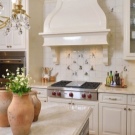



There are two ways of air purification - flow and recirculation. In flow-through mode, the hood is connected to the air duct facing the street or to the ventilation shaft of the house. In recirculation mode, the air is cleaned by filters and returned to the room. Such a device can be installed in a kitchen with forced ventilation. Most of the dome hoods operate as flow hoods. Combined models are available.



The devices can be equipped with the following filters.
- Fat-absorbing. They are installed externally and can be removed if necessary. Experts advise to regularly remove residual fat from them with detergents.
- Coal. These filters are built-in, located inside the device. Absorbs vapors and neutralizes food and burning odors. From time to time they need to be replaced with new ones.


The main indicator of the efficiency of the hood is its performance. It is measured by the volume of air that the device can pass in an hour. This indicator has nothing to do with power, which is determined by the amount of electricity required to operate the device. It is believed that the highest productivity is with flow-through hoods, in which carbon filters are not installed.

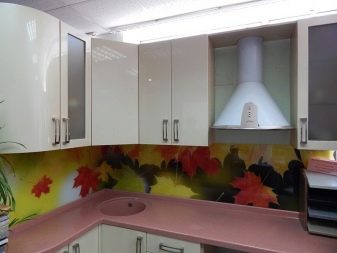


An approximate calculation of the required performance can be done using the formula:
(x • y • z) • 1.3 • 12
(x • y • z) - the volume of the kitchen (the product of length, width and height); 1.3 is a coefficient that takes into account circumstances that reduce the performance of the device; The air in the kitchen must be refreshed 12 times per hour in accordance with sanitary standards.
Other parameters that will help determine the choice of a device are also useful to know.
- The control method is mechanical or touch. Mechanical is provided in inexpensive models - these are buttons or sliders. It is not always convenient to remove dirt from them, which interferes with work and spoils the appearance of the hood. More expensive ones are equipped with displays and remote control.
- Number of engines. In standard devices with a width of 60 cm, 1 motor is installed. The hood with a width of 90 cm and more can be powered by two motors. But this will increase not only its productivity. Energy consumption and noise levels will increase.


- It is better if the sound of a working device is not louder than 45-50 decibels. This is sometimes achieved by installing two less powerful motors instead of one, which can negatively impact performance. The noise level of cheap models is approaching 60 decibels.
- Filter clogging indicators - applied to the filter or displayed on the body in the form of bulbs. You should not ignore their signals: this will greatly reduce the performance of the device and increase the load on the engine.
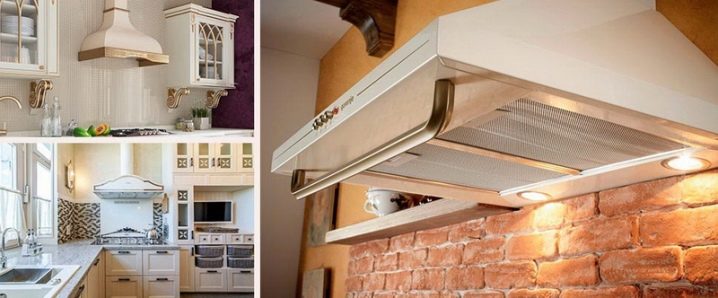
- The presence of an anti-return valve will prevent air from flowing from the ventilation shaft into the apartment when the hood is turned off.
- The backlight and timer will make the use of the device more comfortable: automatic switching on, switching off, working in a pre-programmed mode, using halogen lamps are possible. Incandescent or fluorescent lamps can also be installed.
- The width of the hood should be equal to the width of the stove or hob. Standard sizes are 50, 60 and 90 cm, but there are wider or narrower models.


The design and usability of the hood largely depend on the material from which it is made. The most reliable and easy-to-care products are made of stainless steel or galvanized steel. They will not lose their attractive appearance from periodic cleaning, sudden changes in temperature and the action of time. Of other metals, an alloy of aluminum, copper and brass is used.
The surface of metal devices can be enameled and powder coated. The most durable coating is spraying, especially if the hood is colored. The result is a beautiful polymer layer. The enamelled surface is easy to keep clean, but its appearance is inferior to other materials. Plastic is a cheaper material, and it also allows you to experiment with shape and color. However, it breaks down faster.

Extraordinary surfaces are also created from wood and tinted glass. They are more often used in conjunction with metal structures - this prolongs the life of the device. Hoods with finishing from these materials look stylish and can become one of the accents in the interior of the kitchen. But surfaces made of these materials require careful and careful maintenance. The smallest dirt is visible on glass, especially dark glass.

If steel gray appliances seem boring, but you want to choose a brighter and more interesting one, then it is better to choose one that combines several materials.
Views
Dome hoods can be divided into three groups.
They differ in shape and are designed for rooms with different layouts.
- Island hoods installed in spacious kitchens with a central hob. They are fixed to the ceiling using a cable system. The location can be changed if necessary. This will be possible if a flexible extension chimney is installed. Most of these hoods function only in flow mode.
- Fireplace appliances, or wall-mounted, are located on the wall above the slab: the back, their wall panel is flat. The name was given due to the similarity with exhaust systems for fireplaces. The chimney hoods have a combined air purification mode. If necessary, the device can be hidden in a camouflage closet. Then its dimensions are selected so that a small gap remained between the walls and the hood.
- Corner specially designed for rooms where the stove is located in the corner. Despite their unusual shape, their width is also designed for a standard plate and ranges from 50 to 90 cm. The price for corner hoods starts from 40 thousand rubles.


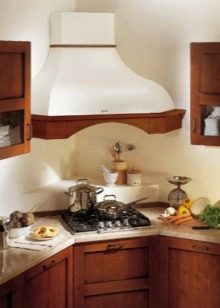
Installation and connection
If you touch the process of installing a fireplace hood, then having your own outlet will simplify the work.
If you need to connect it to a common network, then it is better to entrust this task to a professional.
- The hood installation can only be started after the kitchen furniture has been put in place. For convenience, the location of the hood can be marked on the wall. The exact value of the installation height for a particular device should be indicated in the documentation. For electric stoves, it ranges from 65 to 75 cm, and for gas - from 75 to 90 cm.
- Having marked the line of attachment, determine the dimensions of the device and the duct together. The excess part of the duct is cut off.
- Next, you need to make holes in the wall and insert dowels into them. Then screw the fixtures for the device with the bolts. To accurately determine their place, first measure the wall part of the hood and draw its axes (horizontal and vertical) on the wall. The holes should be located at the ends of the axles.
- Install the upper part of the hood and fix it with screws. Using a level, check whether it is evenly located. Next, you need to attach the lower part and connect the outlet of the device to the ventilation system.


The installation of the island hood follows the same principle.
- The appliance must be located directly above the hob. An air duct and an electric cable protected by a cable channel are pulled to it.
- Holes are made in the ceiling for fasteners, a platform is installed.
- Then the parts are mounted on which the body will be held.
- Check the position of the hood and connect the power cable and air duct to it.


If the operating mechanism is flow-through, then the device must be connected to the ventilation.
You can use a flexible corrugated tube or rigid plastic.
- The advantage of aluminum corrugated pipes is the ability to bend around any obstacles. It is indispensable if there are corners or pipes on the way from the hood to the ventilation. But its appearance does not fit into all interiors, and it often has to be hidden.
- The plastic air duct looks more aesthetically pleasing, but there will be fittings and at least 2 adapters for it. All connections must be sealed with sealant.


Advantages and disadvantages
Dome models of flow-through action are distinguished by high productivity. They purify the air as much as possible from impurities and combustion products harmful to humans. Moreover, judging by the reviews, budget models do their job no worse than expensive ones. However, they work noisily. The level does not exceed the established standard - 60 decibels, but people with high sensitivity will be annoyed, like the sound of a hairdryer or a washing machine.

Manufacturers offer hoods of different designs: classic, high-tech and modern. This makes it easy to choose the right appliance for your kitchen setting. Dome hoods start at 50 cm in width and can look bulky. In a small kitchen, it is better to install a built-in model.

It is not difficult to install the hood itself: a little skill in using a perforator is enough. It is attached without any problems with your own hands, without helpers. But for models with flow-through air cleaning, you will have to lay an air duct.
Examples in the interior
Due to their size, dome-type devices cannot be invisible.
You can harmoniously fit them into the interior in two ways:
- choose a neutral model: its design should be simple, and the color should not stand out very much against the background of the kitchen set.
- make the hood one of the key elements of the furnishings, which cannot be overlooked.
The main thing in this example is a table with an unusual shape. And the hood was chosen as simple as possible: steel, without decor. Its color and material contrast with the facades, but this contrast is reduced by the metal details of the furniture. Thanks to this, the device does not become the center of the composition, fading into the background.
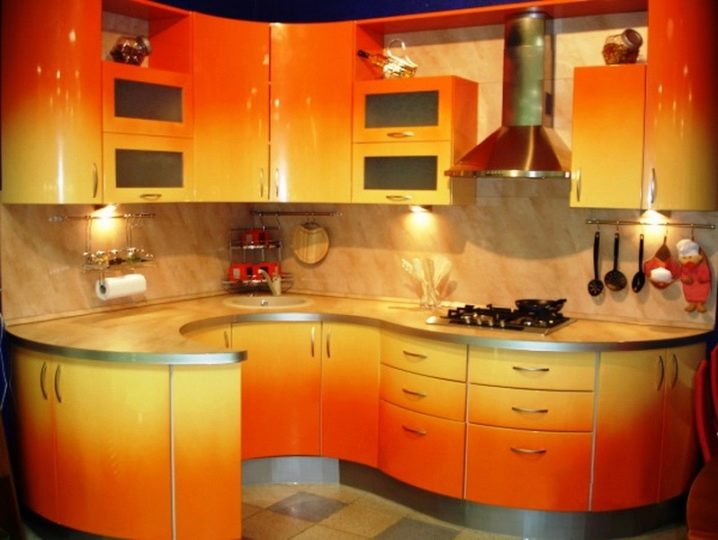
And here the "hearth" is clearly identified, of which the hood is a part. It stands out for its fancy shape, color, and surface texture. Wooden linings both decorate it and connect it with other elements of the kitchen.
How do you find a device that doesn't ruin your overall experience? In kitchens decorated in classic style or with "rustic" interiors, white and light appliances look beautiful. They are often stylized as hearths.

Mantel hoods with antique-style decor fit well into the classics: reliefs, details in the form of cornices, imitation of sandstone tiles. They can be decorated quite strictly or luxuriously, as in the photo. In a small kitchen, it is better to install a more modest option.
Classics don't have to be white. Austere dark furniture can be supplemented with a laconic hood of a similar color.

Choosing a hood for interiors in country and Provence style, you can choose a light model with wood trim. The surface can be decorated with painting, this option will fit into the Provence style.In this case, the simple domed cooker hood was transformed by details in the same color as the furniture. The flower decoration was the finishing touch. Copper-styled metal also looks good. In a loft-style kitchen, steel appliances of a simple shape, without decorative details, will be appropriate. This style is good because the wires and air ducts can not be hidden, but made part of the composition. The hood was chosen as simple as possible, not attracting attention.


The high-tech interior will be decorated with simple metal appliances and unusual models that combine metal and glass. However, not all domes fit into such kitchens. It will be easier to find a suitable model among inclined or exhaust pipes. The surface of the appliance reflects adjacent objects. Thanks to this, it does not catch the eye, but it also does not merge with the wall. The hood softens the contrast between the black furniture and the white wall a little. Another dark object appears, but it does not draw attention to itself.

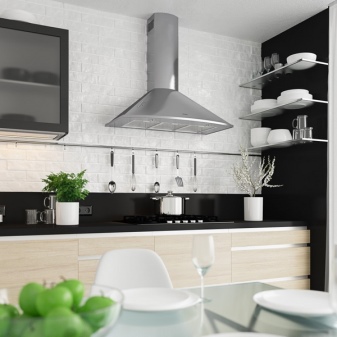
Here, on the contrary, the black hood stands out sharply against the background of other objects. The combination of black and red creates a catchy yet stylish interior.
Dome-shaped hoods are reminiscent of ancient hearths and fireplaces. The right appliance will make any kitchen more comfortable. Manufacturers offer different options: expensive and cheap, simple and ornate. Knowing the technical characteristics will help you make the right choice.
For an overview of domed hoods, see the following video.













The comment was sent successfully.